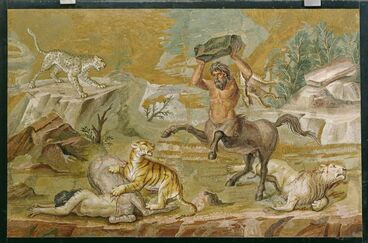
The Centaurs Floor Mosaic, 120-130AD, Tivoli, Italy
Brief Identification[]
This Centaurs Floor Mosaic captures a centaur attacking its prey at Hadrian's Villa in Tivoli, Italy. The mosaic dates back to 120-130AD and was created by numerous natural stones that varied in color. The artwork remains as a floor decoration in the dining room of the main palace within Emperor Hadrian’s extensive villa complex. The complex is located in the eastern region of Rome. The mosaic was likely created to showcase the wealth of the royal family.
Technical Evaluation[]
The Centaurs Mosaic’s dimensions are (58.5 x 91.5 cm). The piece of work consists of different natural stones and serves as a decoration in the house.
The floor Centaurs Mosaic reflects the financial status of family. During the Hellenistic age, the Hellenistic states were ruled absolutely by kings. These kings had a cosmopolitan view of the world, and were particularly interested in amassing as many throughout the Hellenistic world. They put their wealth on display for all to see by building elaborate palaces and commissioning art, sculptures and extravagant jewelry.
Local Historical Context[]
The Centaurs Floor Mosaic was created around 120 AD- 130 AD during the Hellenistic age.
The Hellenistic age started after Alexander The Great died in 323 B.C. (known as the Diadochoi). Before he died, he divided his conquered lands amongst the kings. Soon, those fragments of the Alexandrian empire had formed into three power dynasties: the Seleucids of Syria and Persia, the Ptolemies of Egypt, and Antigonids of Greece and Macedonia. These dynasties were not politically united upon Alexander’s death; they were no longer part of any Greek or Macedonian empire. However, they did share a great deal in common. It is these commonalities, the essential “Greek-ness” of the disparate parts of the Alexandrian world, that historians refer to when they talking about the Hellenistic Age.
The Centaurs Mosaic was used to decorate the floor and represent the family's wealth. In Hellenistic art and literature, this alienation expressed itself in a rejection of the collective demos and an emphasis on the individual. For example, sculptures and paintings represented actual people rather than gods or idealized “types”. At the same time, many people joined “mysterious religions,” like the cults of the goddesses Isis and Fortune, which promised their followers immortality and individual wealth.
World Historical Significance[]
The Hellenistic Age is a part of the Ancient Period for the European and near Asian space. The use of this period is justified by the extent of the Hellenic culture in most of these areas due to the Greek political presence. This presence was heavily seen in Asia after Alexander’s conquests but also to a new wave of Greek colonization.
Thus, Hellenistic civilization represents a fusion of the Ancient Greek world with that of the Near East, Middle East and Southwest Asia, and a departure from earlier Greek attitude towards barbarian cultures.
According to the Altes Museum Berlin , the piece is "one of the most significant Roman mosaics". Presumably, it was modeled after a Greek painting or mosaic from the Hellenistic period.”
Bibliography[]
- Scardamagile, Georgia Susanna.
"Ancient Roman + Pompei + Ercolano." Pinterest. N.p., 2014. https://www.pinterest.com/pin/336433034636892163/
2. "Mosaic: Pair of Centaurs Fighting Cats of Prey from Hadrian's Villa, C. 130 AD, Altes Museum Berlin - a Photo on Flickriver." Mosaic: Pair of Centaurs Fighting Cats of Prey from Hadrian's Villa, C. 130 AD, Altes Museum Berlin - a Photo on Flickriver. Following Hadrian, 11 Dec. 2010. http://www.flickriver.com/photos/carolemage/5399677686/
3.Hisotry.com. "Hellenistic Greece." History.com. A&E Television Networks, 2010.
4.Simonin, Antoine. "Hellenistic Period." Ancient History Encyclopedia. N.p., 28 Apr. 2011. http://www.ancient.eu/Hellenistic_Period/
5."TimeMaps." Atlas of World History. TimeMaps, n.d. Web. 20 Apr. 2015.http://www.timemaps.com/civilization/Hellenistic-period
6. Sweetman, Rebecca J. "The Mosaics of Roman Crete: Art, Archaeology and Social Change." . Cambrige Univerisity Press, 2013.
7. Havelock, Christine Mitchell. Hellenistic Art; the Art of the Classical World from the Death of Alexander the Great to the Battle of Actium. Greenwich, CT: New York Graphic Society, 1970. Print.
8. Welles, C. Bradford, and Alan Edouard. Samuel. Alexander and the Hellenistic World. Toronto: Hakkert, 1970. Print.